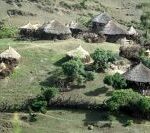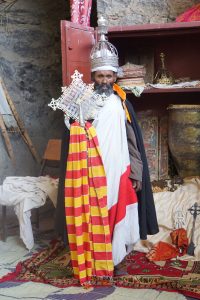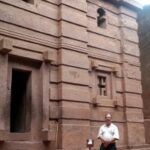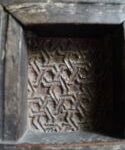The second biggest country most Americans know nothing about may well be Ethiopia. (In case you’re wondering, I think Indonesia is first). It has almost 100 million citizens, with an average income of $500, or so I was told. The country resisted colonization (the only country in Africa to do so, defeating an Italian army in the 1890s at Sadowa which prompted Mussolini’s conquest in the 1930s). Admiration for its independence has made its red, green, and yellow flag colors repeated in other African countries, said my guide. It has had a long series of dynasties, some lasting 8 centuries; the most recent was under Haile Selassie, the Lion of Judah, who was deposed in a communist coup in 1971, and the communist rule lasted until 1989. As in South Africa, the triumphant rebels continue to rule, with less and less justification. There are 500 delegates to Parliament—and only one opposition party member was elected. My guide, who proudly associates with the opposition, said he was “jailed” during the election for his political activities! I’m sure it’s ranked as one of the most corrupt countries in the world—which may well explain why there are one million Chinese in the country, enlarging the airport (much needed) and building infrastructure.
I was briefly in Addis (over 2500 miles from Johannesburg, and 7500 or so miles from you), and what I saw was a reminder that I’m in the third world again. The city of about 5 million (a pretty small percentage of the population, which means there are a lot of small towns and farmers) seems unfinished, like a Chinese city in the late 80s or early 90s. Lots of small, temporary type stores selling all manner of goods, from produce to clothing. Lots of dust and construction. Building cranes everywhere. As the headquarters of the African union, however, Ethiopian nationalists like to claim it is the “capital of Africa.” I’m hoping I’ll have some time next week on my last day in Ethiopia to visit the national museum and the ethnology museum (which is Haile Selassie’s ex-palace).
When I got to Lalibela, at 8000 feet, I realized why Ethiopians do well in marathons, but it’s not just the altitude that’s left me breathless. It’s a city  of under 40,000 people, with donkeys and tuk-tuks (3 wheeled covered taxis) the predominant form of transportation. There’s lots of thatched houses in the countryside, with the main distinction between animal and people residences being size. There’s a “Chinatown” housing the Chinese workers who are replacing the mostly dirt roads with concrete; they live in a gated compound in the city—the forbidden city? I’m staying at the well-named Mountain View hotel, where the left-behind book shelf offers only German and Chinese copies. I think most of the other guests are German, and I’m happy to say that I was the only one who ordered the flat pancake covered with a variety of vegetables that I remember as “Ethiopian food” in the states.
of under 40,000 people, with donkeys and tuk-tuks (3 wheeled covered taxis) the predominant form of transportation. There’s lots of thatched houses in the countryside, with the main distinction between animal and people residences being size. There’s a “Chinatown” housing the Chinese workers who are replacing the mostly dirt roads with concrete; they live in a gated compound in the city—the forbidden city? I’m staying at the well-named Mountain View hotel, where the left-behind book shelf offers only German and Chinese copies. I think most of the other guests are German, and I’m happy to say that I was the only one who ordered the flat pancake covered with a variety of vegetables that I remember as “Ethiopian food” in the states.
I came to Lalibela for an understanding of Ethiopian culture, particularly of its 60% Christians, who follow (for reasons I’ve been told I’ll understand better when I go to Askum, which was the capital when Christianity came to this country), the Orthodox faith. In the 16th century, one king invited European help to combat the Muslims; Portuguese came, and he converted to Catholicism as a result. His successor threw the Portuguese out, and resumed Orthodoxy. Lalibela was the seat of power of one of the dynasties looking for respite from the Muslim drive in the north, which pushed the Christians farther inland. Muslims are still numerous (35% or so, more in the east), and either co-exist peacefully, or are getting Middle Eastern money to agitate for separation or superiority, depending on whom you talk with. Lalibela was the most powerful king of the dynasty; he refused to support the Crusaders, for which Saladin reputedly granted the right to guard sacred Christian relics in Jerusalem (to this day, the various sites are guarded by various Churches). But he did leave 13 churches and chapels and monasteries that are still active today in this heavily Christian town. When I asked my guide about AIDS, he replied, “Not in Lalibela; we’re Christian.”

I spent about 6 hours touring with my guide, a 28 year old young man who wants to go back to school to study criminal justice and then pursue a political career. As I mentioned, he’s thrown his lot with the opposition party, and paid for it with jail time. He’s well connected locally, with a grandfather who was the priest in charge of St. George, the last of the rock-hewn churches; his dad, he admitted, was an official under the communists who did a lot of “bad things,” and died in prison after the overthrow of the communist party.
He had a lot of information about the 7 churches/monasteries we saw today, and what fascinated me were the connections I was able to draw with the Byzantine world I’ve been exploring the past four or five years. In fact, until the 1950s, the Church was under the Patriarch(?) of Alexandria. Haile Selassie declared its independence. I could see what was borrowed. Much of the historical interpretation is hindered by the lack of documentation. Apparently, the major document was looted by the Italian army and has either disappeared or is in the Vatican library. The tradition states that King  Lalibela had a vision of Jerusalem, and tried to construct similar buildings in two sets of churches chiseled out of rock. The architectural work is fantastic, and it probably drew on stone masons from much of the Christian world, since there are Maltese crosses and other non-orthodox symbols,
Lalibela had a vision of Jerusalem, and tried to construct similar buildings in two sets of churches chiseled out of rock. The architectural work is fantastic, and it probably drew on stone masons from much of the Christian world, since there are Maltese crosses and other non-orthodox symbols,  including a Buddhist “swastika” (it’s not the Nazi variety), and a Star of David, not to mention a Jordan River, and symbolic graves for Abraham, Isaac, and Jacob. These were carved out of one piece of rock! St. George, probably the best known one, or at least the most photogenic from above (it’s in the shape of a cross, with no inside pillars), is fashioned from basalt, a much harder rock, making it smaller, but a beneficiary of all that went before. Lalibela is deservedly a world class UNESCO site, and part of the reason that I think Ethiopia ought to be more well known. As one of the early Portuguese explorers wrote, and I’m paraphrasing, “People would not believe me if I told them more.” He’s right. I’ll see if I can upload some pictures to share with you why I’m breathless here—and it’s more than the altitude. As an ex Committee Chair noted, “This is Fred Heaven.” Or at least one variant of it.
including a Buddhist “swastika” (it’s not the Nazi variety), and a Star of David, not to mention a Jordan River, and symbolic graves for Abraham, Isaac, and Jacob. These were carved out of one piece of rock! St. George, probably the best known one, or at least the most photogenic from above (it’s in the shape of a cross, with no inside pillars), is fashioned from basalt, a much harder rock, making it smaller, but a beneficiary of all that went before. Lalibela is deservedly a world class UNESCO site, and part of the reason that I think Ethiopia ought to be more well known. As one of the early Portuguese explorers wrote, and I’m paraphrasing, “People would not believe me if I told them more.” He’s right. I’ll see if I can upload some pictures to share with you why I’m breathless here—and it’s more than the altitude. As an ex Committee Chair noted, “This is Fred Heaven.” Or at least one variant of it.